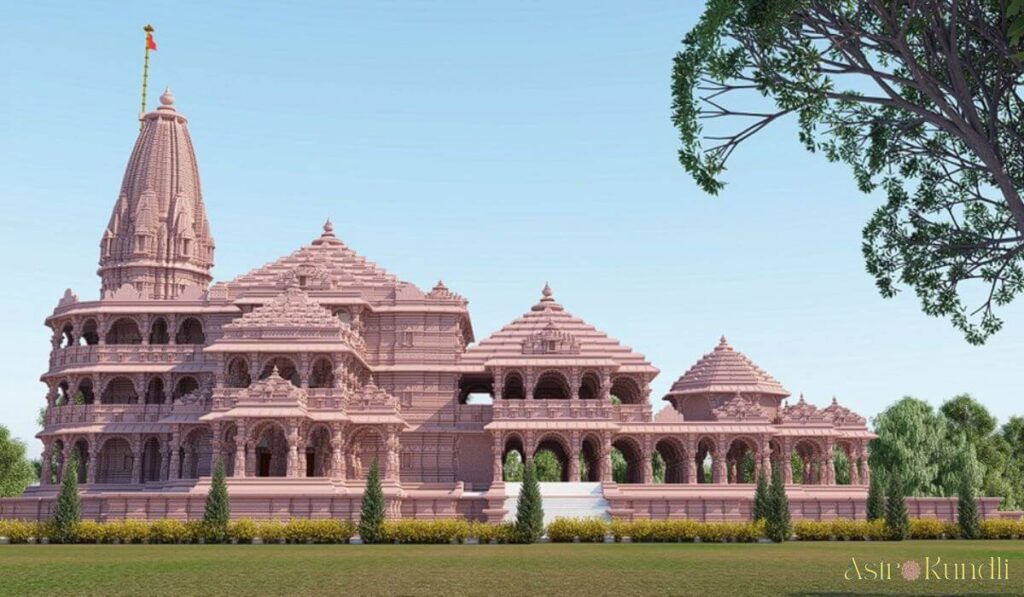Table of Contents
The Ayodhya Ram Mandir is not only a temple of brilliant architecture and design. It stands as a symbol of faith, strength and stunning architecture. This article will cover information about the area of the temple and its complex architecture. Let’s dive into the fascinating details of this magnificent architectural marvel that is set to become an iconic site for pilgrimage.
Area and Dimensions
The entire complex in which Ram Mandir or Ram Janmabhoomi Mandir is nestled spans across 70 acres of land (30,49,200 square feet). The temple itself takes up 2.7 acres (1,17,612 square feet) of the complex area. The temple stands at a height of 161 feet making the Ram Mandir one of the most expensive religious projects in years. It’s estimated cost is ₹ 1,800 crore.

Architecture
The chief architect of this project is Chandrakant Sompura. The Sompura family has been known for temple architecture for 15 generations.
Lord Ram’s idol was sculpted by Arun Yogiraj who is a famous sculptor from Karnataka. Additionally, the temple has been designed in Nagara style architecture.
Learn more about the architecture of Ram Mandir
The complex includes
- Garbhagriha: Garbhagriha or the sanctum sanctorum is designed in an octagon shape as per Vastu Shastra principles and ideologies. It will house the idol of Lord Ram in his childhood form. The idol has been named Ram Lalla.
- Antarala (vestibule): This space connects the garbhariha and the rangamanda (main hall). It’s decorated with deities and carvings showing scenes from Ramayana.
- Rangamanda (main hall): This is a vast hall that can cater to thousands of followers and conduct devotional activities and cultural events.
- Parikrama: Around the temple in a circle is a parikrama path. Such paths are traditionally used by devotees to perform circumambulation (a ritualistic walk to show respect).
- Museums and Libraries: There are museums that show Ayodhya’s history and information on the Ram Mandir project itself. Along with libraries for spiritual and religious studies.
- Gardens and Open Spaces: Gardens and open spaces provide a sense of calm and being one with nature in the complex.
What is the temple made out of?
The Ram Mandir stands as a great example of Indian architecture and engineering. Steel and iron were avoided for construction due to their potential of rust. Only large rocks have been used for construction. The temple has been constructed with help of around 20,700 granite blocks, 32,800 sandstone blocks and 7,200 marble blocks. This information was shared by the project engineer, VK Mehta.
He also stated that due to avoiding steel and iron and very less usage of cement the stones have been interlocked. This system ensures a strong structure that can withstand earthquakes and lasts for more than 1,000 years.
Additionally the Ayodhya Ram Mandir is a project constructed by the efforts of 150 engineers and thousands of workers.
Who is overseeing the construction of the Ayodhya Ram Mandir?
The Indian government has allotted this task to the Shri Ram Janmabhoomi Teerth Kshetra Trust. It’s a body organized by the government itself and is responsible for the construction and management of the entire complex.
When is the Ayodhya Ram Mandir expected to be completed?
The temple’s ground floor has already been completed and it is projected that the first and second floors will be completed by December 2024.
How can I stay updated on the latest information about Ayodhya Ram Mandir?
You can stay updated on the information and development of the temple by visiting the official site of Shri Ram Janmabhoomi Teerth Kshetra Trust and their social media accounts.
Frequently Asked Questions (FAQs)
Q1: What is the result of Ram Mandir?
In 2019 the Supreme Court approved the construction of the Ayodhya Ram Mandir. The construction started in 2020 and is ongoing. From an economic stand point this project will boost tourism and pilgrimage in Ayodhya.
Q2: How much Ram Mandir is completed in Ayodhya?
As of January 30, 2024 the ground floor and garbhagriha (sanctum sanctorum) have been completed. The entire project is aimed to be completed by 2025.
Q3: What is the Ayodhya temple matter in English?
The main reason for dispute over the land happened because Hindus believed that the plot of land in Ayodha, Uttar Pradesh is the birthplace of Ram. However there was a mosque called Babri Masjid in the same location which was built in the 16th century.
Overtime the tensions between Hindus and Muslims escalated and the mosque was demolished by Hindu nationalists in 1992. This incident trigerred riots and violence across the nation. The legal battle for the ownership of the land lasted for decades and the Supreme Court eventually ruled in favour of Hindus in 2019.




